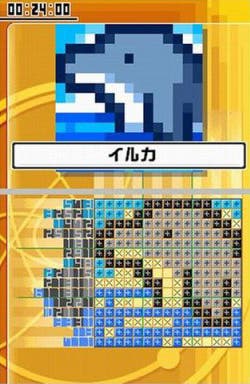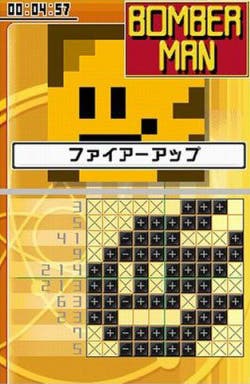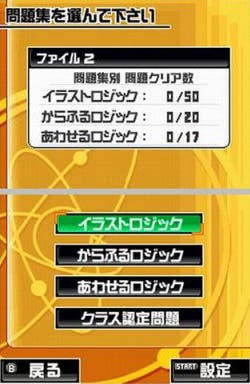Illust Logic DS + Colorful Logic
The Slitherlink of Picross.
Hudson Soft does it again. Picross, done perfectly. Trying to fathom the logic of UK games publishers, and that none of them have picked up the Hudson Soft Puzzle Series, will only hurt your brain. A collection of the most sublime puzzlers, fearfully and wonderfully made, so very perfect for the DS. It only gets more bemusing when you realise that most of these games - Sudoku, Akari, Kakuro, Picross, and of course Slitherlink - appear in national newspapers, magazines and probably the backs of shampoo bottles. Do they not like making money or something?
So of course our constant lament here is that there's no UK release of Slitherlink, despite Tom and me campaigning for it like it's being held hostage by terrorists. So here's another game to get into the same confused frenzy over.
For reasons someone else will explain, Picross is called Illust Logic in Japan, and for the sake of being clear, I'll refer to it as Picross throughout. Are we familiar with that now? Nintendo's own Picross DS has been enormously popular, making it into the 2007 EG Top 50, and reaching a much wider UK audience than the aged puzzle has managed before. Nintendo have always been great at offering Picross, going back to the gorgeous (Japanese only) Mario Picross games on GameBoy and SNES (don't forget to download the SNES version to your Wii). But the title for the best execution is now handed over the Hudson, with a version that demonstrates quite how much Picross DS gets wrong.

So to be clear: Picross is a puzzle where you're given a grid of empty boxes, with numbers across the top and down the side. These numbers tell you how many of the boxes need to be filled in in that row or column. If it says "3, 5" you've got to figure out which three, and then which five, in that row get changed colour. The result is a vaguely recognisable picture, and a feeling of enormous satisfaction. Executing this well proves surprisingly difficult, when you look at the number of clumsy, often unplayable versions the DS has seen. And madly, it seems the main mistake, contrary to all instinct, is to focus on the stylus.
Like Picross DS, Illust is best played with the buttons. And by "best played", I mean "an absolute joy to play". These people know how thumbs are wired to brains, and create the most clear connection between the two. Which is interesting when you put it alongside Vol. 6 of the Puzzle Series, Hudson's previous Picross game, which is comparatively a complete mess. A nasty design, splodgy controls, and lacking the necessary happiness, it's hard to put up with after either Nintendo's version or this.
Describing why Illust Logic is so great is pretty tricky, so you'll have to bear with me through some clumsy sentences. Here goes. If you've played Picross DS, you'll know that you fill in the squares by selecting each with the d-pad, then pressing A to put in a block, B to put in an X to denote that you're aware nothing goes there. And you'll know that you can helpfully fill in an entire row of Xs by holding B and holding a direction. And better, it knows not to replace a filled in block with an X when you do this. That's excellent design. Illust does it so much better. There's something slightly wrong with Nintendo's system. It doesn't intuit your intention when filling in a whole row, often feeling quite laborious to perform accurately (you don't agree? That's because you haven't played this version yet). Illust somehow knows what you're thinking, meaning you can glide through puzzles in a sublimely graceful way.

Another example - and this may sound enormously specific, but believe me it makes such a difference - is that when you've reached the right of the grid, clicking right again will take you back to the left, and the same for up and down. Not having to drag your way back through the tiles over and over makes things even more fluid. But Hudson hasn't made the same mistake it made with Vol. 6 - it doesn't automatically overlap this way. If your dragging Xs or blocks across a row, it will come to a stop at the end, waiting for a second direction click from you. It's such a tiny detail, but it represents the depth of understanding the designers have for their players. Like Slitherlink, they've said, "We have a relatively simple puzzle here. Let's now spend an enormous amount of effort making it as delightful to play as possible."
Another thing that bugs me about Picross DS is the lack of incentive to finish quickly. I don't want to be in a tremendous rush, but I do want to be congratulated for being efficient. Illust hits this spot on with Hudson's traditional star ratings. Complete a 15x15 grid in under 10 minutes, and you'll get five out five stars. Finish a 20x20 in fewer than 15, and you'll get six out of six. Not only does this represent a fair system for being able to max out, but it gives you an incentive to replay a puzzle later on to improve your star rating. (Current count for me: 1987). This is something else Hudson screwed up in the previous game, making the max stars stupidly difficult to achieve, this time done to perfection.
Where it clearly falls short of Picross DS is in the lack of downloadable content. Not being able to download your daily puzzle, or get access to the Mario grids, or any of the other bonuses makes a difference. Where it makes up for this is in the inclusion of Colour Picross.

If you've never tried a colour Picross, it's a whole new world. When you're completely familiar with the rules, tricks and shortcuts for a regular Picross puzzle, playing a colour puzzle is a shock. You can no longer base your logic around the gaps between the blocks, as there's no need for a gap between two blocks of different colours. Once again what you must fill in is designated by the numbers at the edge of the screen, this time the number in the colour of the block it denotes. You quickly realise you're going to have to teach yourself a new collection of tactics for approaching these. Joy!
It's all in Japanese, but the menus are reasonably simple to navigate. And best, after your first time through, it remembers the options you chose the next time you load it. So getting to the page you want requires only hammering A. There's a ton of puzzles in here, in categories I can't quite fully fathom, each category starting with 10x10 grids, growing to 20x20. Rather nicely, quite a lot of the puzzles result in creating characters or logos from previous Hudson games, some mystifyingly Japanese, others, well, Bomberman.
Lacking the online gubbins of Nintendo's popular game puts a dent in it. But beyond this, this is Picross offered as perfectly as you could ever desire. It's so intuitive, intelligent, and aware of how you want to play, in a way I can only compare with Hudson's own Slitherlink. And because UK publishers are all morons (yes, all of you) it'll never get a release over here. So, to your favourite Japanese import site with you.

